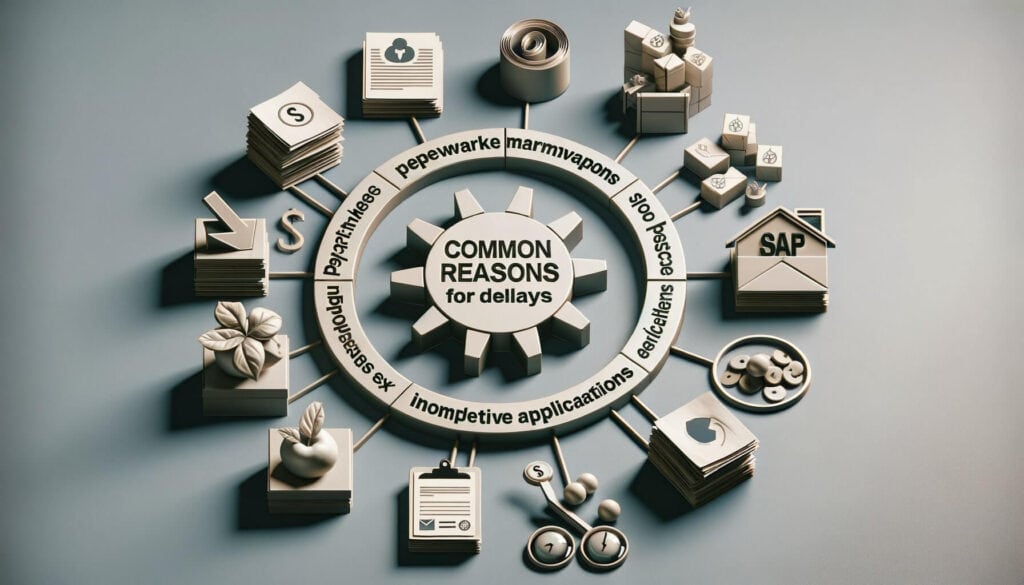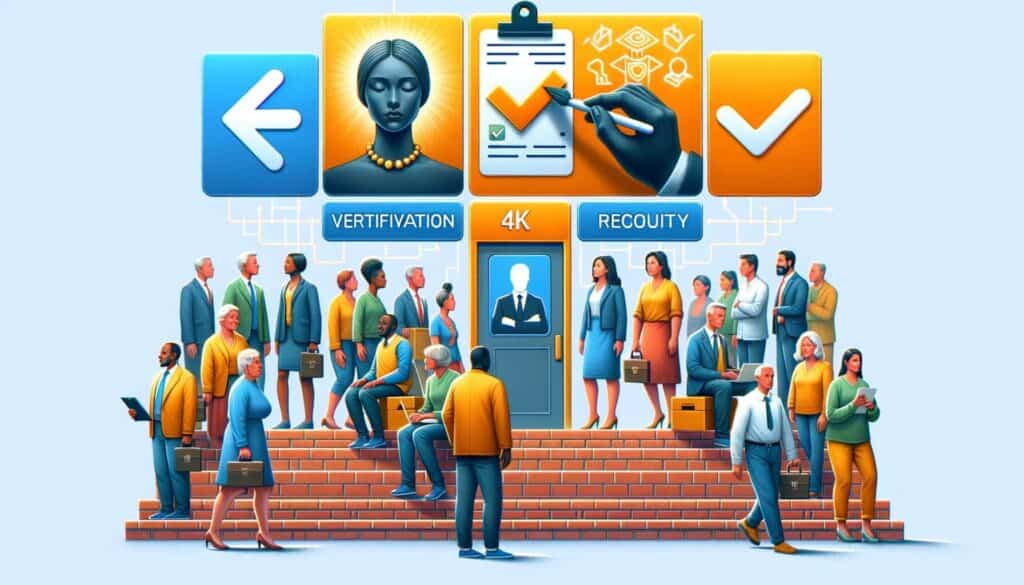
By Sharon Watson January 30, 2025
The Supplemental Nutrition Assistance Program (SNAP), formerly known as the Food Stamp Program, is a federal assistance program in the United States that provides eligible low-income individuals and families with funds to purchase food. SNAP benefits are crucial for millions of Americans who struggle to afford nutritious meals. However, many recipients often face delays in receiving their benefits, causing significant hardships.
In this article, we will explore the reasons behind SNAP benefit delays, the application and verification processes, potential issues with eligibility determination, administrative delays, and how to seek assistance when facing benefit delays.
How Does the SNAP Program Work?

The SNAP program is administered by the United States Department of Agriculture (USDA) and operates in all 50 states, the District of Columbia, Guam, and the Virgin Islands. It aims to alleviate hunger and improve nutrition by providing eligible individuals and families with an Electronic Benefit Transfer (EBT) card, which functions like a debit card. Recipients can use the EBT card to purchase eligible food items at authorized retailers, including grocery stores, supermarkets, and farmers’ markets.
To qualify for SNAP benefits, individuals and families must meet certain income and resource requirements. The income eligibility threshold is set at 130% of the federal poverty level, although some states have higher thresholds. Resources, such as bank accounts and vehicles, are also considered when determining eligibility. Additionally, applicants must be U.S. citizens or legal immigrants with certain qualifications.
Common Reasons for SNAP Benefit Delays

Despite the importance of SNAP benefits, delays in receiving them are unfortunately common. Several factors contribute to these delays, including administrative issues, verification processes, and eligibility determination challenges. Let’s explore some of the most common reasons for SNAP benefit delays:
1. Incomplete or Inaccurate Applications: One of the primary reasons for benefit delays is incomplete or inaccurate applications. Applicants must provide detailed information about their income, expenses, household composition, and other relevant details. Any missing or incorrect information can lead to delays as caseworkers need to request additional documentation or clarification.
2. Verification Process: The verification process is another potential cause of delays. SNAP applicants are required to provide documentation to support the information provided in their applications. This may include pay stubs, bank statements, rent receipts, and utility bills. If applicants fail to provide the necessary documentation or if there are discrepancies, the verification process can be prolonged, resulting in benefit delays.
3. High Volume of Applications: The SNAP program serves millions of individuals and families across the country. During periods of economic downturn or increased need, the volume of applications can overwhelm the system, leading to delays in processing and distributing benefits.
4. Changes in Circumstances: SNAP recipients are required to report any changes in their circumstances, such as income, household composition, or address. Failure to report these changes promptly can result in benefit delays as the information needs to be updated and verified.
5. Technical Issues: Like any system, the SNAP program relies on technology for processing applications and distributing benefits. Technical glitches, system maintenance, or other IT-related issues can cause delays in benefit distribution.
Exploring the Application Process for SNAP Benefits

To apply for SNAP benefits, individuals and families must complete an application form, which can be obtained online, in person at a local SNAP office, or by mail. The application requires detailed information about income, expenses, household composition, and other relevant details. It is crucial to provide accurate and complete information to avoid delays in processing.
The application process typically involves the following steps:
1. Completing the Application: Applicants must fill out the application form accurately and completely. It is essential to provide all requested information and answer all questions truthfully.
2. Submitting the Application: Once the application is completed, it can be submitted online, in person, or by mail. Online submission is often the quickest and most convenient method.
3. Interview: In some cases, applicants may be required to participate in an interview with a caseworker. The purpose of the interview is to verify the information provided in the application and gather any additional required documentation.
4. Providing Documentation: Applicants must provide documentation to support the information provided in their application. This may include pay stubs, bank statements, rent receipts, utility bills, and proof of identity. It is crucial to gather and submit all required documentation promptly to avoid delays.
Understanding the Verification Process for SNAP Benefits

Once the application is submitted, it undergoes a verification process to ensure the accuracy of the information provided. The verification process involves cross-checking the information with various databases and requesting additional documentation if necessary. This process is crucial for maintaining the integrity of the SNAP program but can also contribute to delays in benefit distribution.
The verification process typically includes the following steps:
1. Cross-Checking Information: Caseworkers cross-check the information provided in the application with various databases, such as income databases, employment records, and immigration databases. This helps verify the accuracy of the information and determine eligibility.
2. Requesting Additional Documentation: If there are discrepancies or missing information, caseworkers may request additional documentation from the applicant. This can include pay stubs, bank statements, rent receipts, utility bills, and other relevant documents. It is essential to provide the requested documentation promptly to avoid delays.
3. Contacting Third Parties: In some cases, caseworkers may need to contact third parties, such as employers or landlords, to verify the information provided by the applicant. This can add additional time to the verification process.
4. Review and Decision: Once all the necessary information and documentation have been gathered, caseworkers review the application and make a decision regarding eligibility. If the application is approved, the benefits will be issued. If there are issues or discrepancies, the applicant may be required to provide further clarification or documentation.
Potential Issues with SNAP Benefit Eligibility Determination
Determining eligibility for SNAP benefits can be a complex process, and there are several potential issues that can contribute to delays. Some of the common issues include:
1. Income Calculation: Calculating income accurately is crucial for determining eligibility. However, income calculation can be challenging, especially for individuals with irregular or fluctuating income. Additionally, different states may have different rules and methodologies for income calculation, leading to inconsistencies and delays.
2. Resource Calculation: Resources, such as bank accounts and vehicles, are also considered when determining eligibility. However, calculating resources accurately can be complicated, especially when there are joint accounts or shared assets. Discrepancies or delays in resource calculation can result in benefit delays.
3. Household Composition: SNAP benefits are based on household composition, and changes in household composition can affect eligibility. However, determining household composition accurately can be challenging, especially in cases of shared custody or complex living arrangements. Delays can occur when caseworkers need to gather additional information or verify the accuracy of the information provided.
4. Immigration Status: Eligibility for SNAP benefits is also influenced by immigration status. Non-citizens must meet certain qualifications to be eligible for benefits. Verifying immigration status and determining eligibility can be a complex process, leading to potential delays.
Addressing Administrative Delays in SNAP Benefit Distribution
Administrative delays can occur at various stages of the SNAP benefit distribution process, leading to significant delays for recipients. These delays can be caused by a variety of factors, including system glitches, staffing shortages, and bureaucratic inefficiencies. Addressing administrative delays is crucial to ensure timely benefit distribution. Some strategies to address administrative delays include:
1. System Improvements: Investing in technology and system upgrades can help reduce technical glitches and improve the efficiency of benefit distribution. This includes ensuring that online application systems are user-friendly and accessible, and that the EBT card system functions smoothly.
2. Staffing and Training: Adequate staffing levels and ongoing training for caseworkers are essential to ensure efficient processing of applications and timely benefit distribution. Providing caseworkers with the necessary resources and support can help reduce administrative delays.
3. Streamlining Processes: Identifying and eliminating unnecessary bureaucratic processes can help streamline the SNAP benefit distribution process. This includes simplifying application forms, reducing paperwork requirements, and automating certain verification processes.
4. Improved Communication: Enhancing communication between SNAP offices and applicants can help reduce delays. Providing clear instructions and guidance to applicants, promptly notifying them of any issues or missing documentation, and establishing efficient channels for communication can all contribute to faster benefit distribution.
Seeking Assistance for SNAP Benefit Delays
If you are experiencing delays in receiving your SNAP benefits, there are several steps you can take to seek assistance:
1. Contact Your Local SNAP Office: Reach out to your local SNAP office to inquire about the status of your application or benefit distribution. They can provide you with information about any potential issues or delays and guide you on the next steps to resolve the situation.
2. Seek Legal Aid: If you believe that your benefit delay is unjustified or if you are facing significant hardships due to the delay, you may consider seeking legal aid. Legal aid organizations can provide guidance and support in navigating the SNAP system and advocating for your rights.
3. Contact Advocacy Organizations: There are numerous advocacy organizations that specialize in addressing issues related to SNAP benefits. These organizations can provide guidance, resources, and support in resolving benefit delays.
4. Reach Out to Elected Officials: Contacting your elected officials, such as your local representatives or senators, can help bring attention to your benefit delay issue. They may be able to intervene on your behalf and expedite the resolution of the delay.
Frequently Asked Questions (FAQs) about SNAP Benefit Delays
Q1. What should I do if my SNAP benefits are delayed?
Answer: If your SNAP benefits are delayed, the first step is to contact your local SNAP office to inquire about the status of your application or benefit distribution. They can provide you with information about any potential issues or delays and guide you on the next steps to resolve the situation.
Q2. How long does it take to receive SNAP benefits after applying?
Answer: The time it takes to receive SNAP benefits after applying can vary depending on various factors, including the volume of applications, the accuracy and completeness of your application, and the efficiency of the verification process. In general, it can take anywhere from a few days to several weeks to receive benefits after applying.
Q3. Can I expedite the SNAP benefit application process?
Answer: In certain circumstances, such as when facing extreme hardship or an emergency situation, it may be possible to expedite the SNAP benefit application process. Contact your local SNAP office to inquire about the possibility of expediting your application.
Q4. What should I do if my SNAP benefits are wrong or incorrect?
Answer: If you believe that your SNAP benefits are incorrect or if there are discrepancies in the amount you are receiving, contact your local SNAP office immediately. They can review your case and make any necessary adjustments or corrections.
Q5. Can I receive retroactive SNAP benefits for the delay period?
Answer: In some cases, if there was a significant delay in processing your application or distributing your benefits, you may be eligible for retroactive SNAP benefits. Contact your local SNAP office to inquire about the possibility of receiving retroactive benefits.
Conclusion
SNAP benefits play a crucial role in ensuring food security for millions of low-income individuals and families in the United States. However, delays in receiving these benefits can cause significant hardships and exacerbate food insecurity. Understanding the reasons behind SNAP benefit delays, the application and verification processes, potential eligibility determination issues, and administrative delays is essential for addressing and resolving these delays.
By taking proactive steps such as providing accurate and complete information in the application, promptly submitting required documentation, and staying informed about the status of your application, you can help minimize delays. Additionally, seeking assistance from your local SNAP office, legal aid organizations, advocacy groups, and elected officials can provide valuable support in resolving benefit delay issues.
Efforts to address administrative delays, such as system improvements, staffing and training, streamlining processes, and improved communication, are also crucial for ensuring timely benefit distribution. By working together, individuals, organizations, and government agencies can strive to minimize SNAP benefit delays and ensure that those in need receive the assistance they require to access nutritious food.